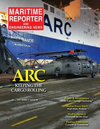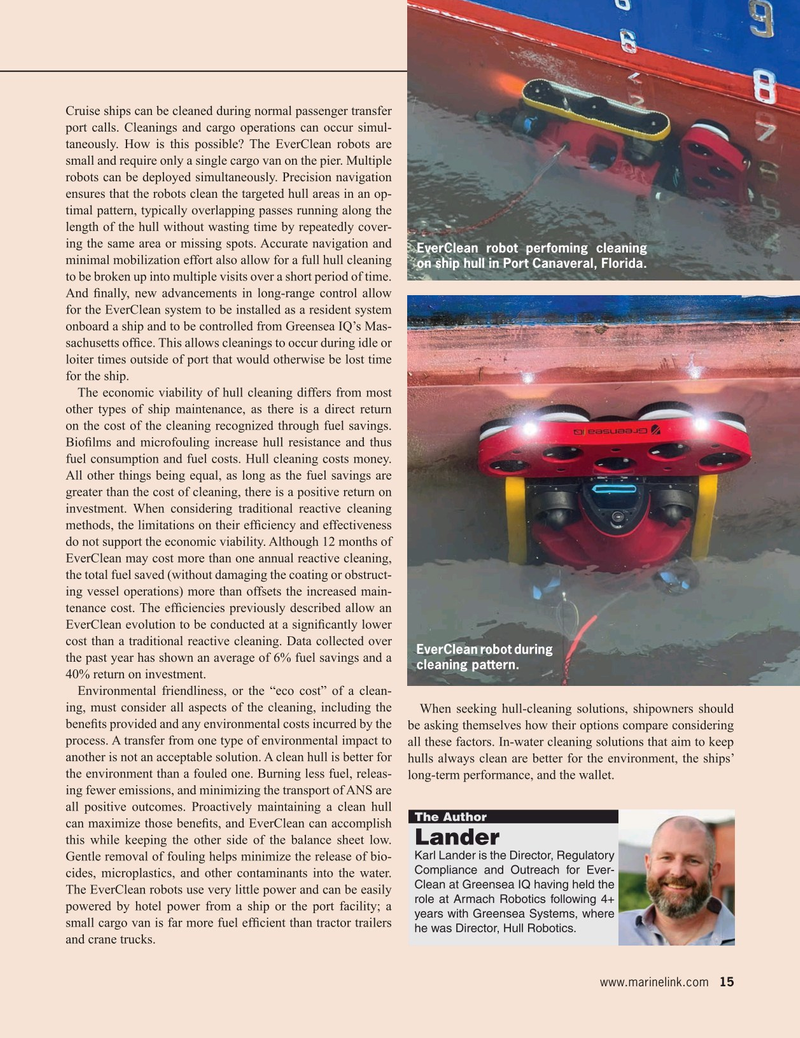
Page 15: of Maritime Reporter Magazine (February 2024)
Read this page in Pdf, Flash or Html5 edition of February 2024 Maritime Reporter Magazine
Cruise ships can be cleaned during normal passenger transfer port calls. Cleanings and cargo operations can occur simul- taneously. How is this possible? The EverClean robots are small and require only a single cargo van on the pier. Multiple robots can be deployed simultaneously. Precision navigation ensures that the robots clean the targeted hull areas in an op- timal pattern, typically overlapping passes running along the length of the hull without wasting time by repeatedly cover- ing the same area or missing spots. Accurate navigation and
EverClean robot perfoming cleaning minimal mobilization effort also allow for a full hull cleaning on ship hull in Port Canaveral, Florida.
to be broken up into multiple visits over a short period of time.
And ? nally, new advancements in long-range control allow for the EverClean system to be installed as a resident system onboard a ship and to be controlled from Greensea IQ’s Mas- sachusetts of? ce. This allows cleanings to occur during idle or loiter times outside of port that would otherwise be lost time for the ship.
The economic viability of hull cleaning differs from most other types of ship maintenance, as there is a direct return on the cost of the cleaning recognized through fuel savings.
Bio? lms and microfouling increase hull resistance and thus fuel consumption and fuel costs. Hull cleaning costs money.
All other things being equal, as long as the fuel savings are greater than the cost of cleaning, there is a positive return on investment. When considering traditional reactive cleaning methods, the limitations on their ef? ciency and effectiveness do not support the economic viability. Although 12 months of
EverClean may cost more than one annual reactive cleaning, the total fuel saved (without damaging the coating or obstruct- ing vessel operations) more than offsets the increased main- tenance cost. The ef? ciencies previously described allow an
EverClean evolution to be conducted at a signi? cantly lower cost than a traditional reactive cleaning. Data collected over
EverClean robot during the past year has shown an average of 6% fuel savings and a cleaning pattern.
40% return on investment.
Environmental friendliness, or the “eco cost” of a clean- ing, must consider all aspects of the cleaning, including the When seeking hull-cleaning solutions, shipowners should bene? ts provided and any environmental costs incurred by the be asking themselves how their options compare considering process. A transfer from one type of environmental impact to all these factors. In-water cleaning solutions that aim to keep another is not an acceptable solution. A clean hull is better for hulls always clean are better for the environment, the ships’ the environment than a fouled one. Burning less fuel, releas- long-term performance, and the wallet.
ing fewer emissions, and minimizing the transport of ANS are all positive outcomes. Proactively maintaining a clean hull
The Author can maximize those bene? ts, and EverClean can accomplish this while keeping the other side of the balance sheet low.
Lander
Karl Lander is the Director, Regulatory
Gentle removal of fouling helps minimize the release of bio-
Compliance and Outreach for Ever- cides, microplastics, and other contaminants into the water.
Clean at Greensea IQ having held the
The EverClean robots use very little power and can be easily role at Armach Robotics following 4+ powered by hotel power from a ship or the port facility; a years with Greensea Systems, where small cargo van is far more fuel ef? cient than tractor trailers he was Director, Hull Robotics. and crane trucks.
www.marinelink.com 15
MR #2 (1-17).indd 15 2/6/2024 9:42:10 AM

 14
14

 16
16
